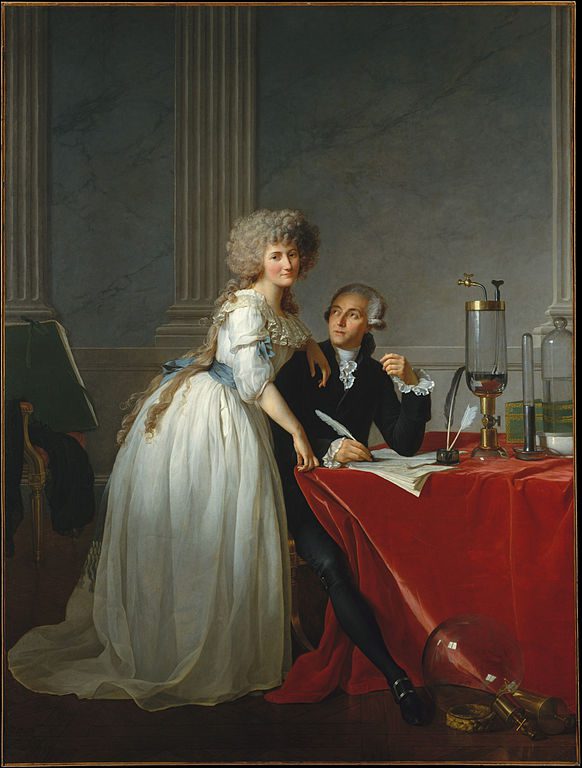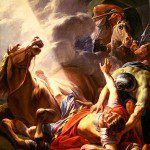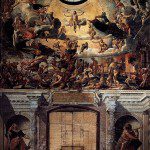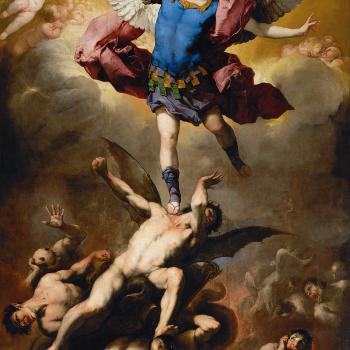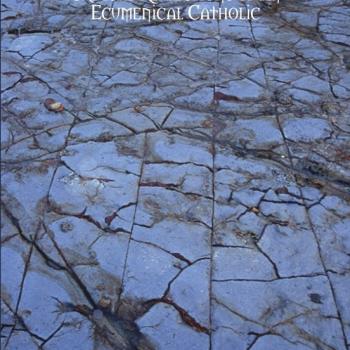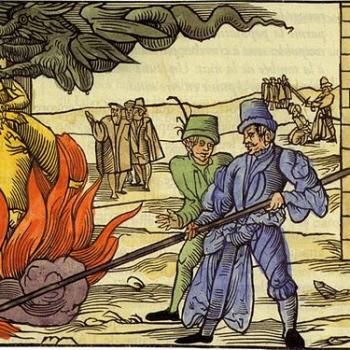* * * * *
Why is it that we always hear, ad nauseum, about Galileo and how he was persecuted by the Catholic Church for saying that the earth went around the sun? Well, there are two reasons: it makes for great copy, because it was a whopper of a scientific error, for a tribunal of the Church to defend geocentrism, and because it is fodder for anti-Catholicism and contra-Catholicism, and even a broader anti-Christianity (and sometimes anti-theism and anti-religion, period). When we Catholics make mistakes, they are never forgotten, and milked (in distorted, half-baked form) for all they are worth, for literally hundreds of years.
Atheists, agnostics, secularists, and many of those on the political left (who have a tendency to replace Christianity with scientism, as their new “religion” and worldview) absolutely love the Galileo story. It’s been wonderful propaganda for them for almost 500 years; that is, in its usual modified, revisionist, one-sided presentation, designed to make the Catholic Church look as bad as it can possibly look, in order to foster the myth that it is somehow “anti-science.” It is somewhat analogous to the way that Martin Luther is used by many Protestants (especially anti-Catholic ones), in the attempt to make the Catholic Church look as unreasonable, improperly dogmatic, and (supposedly) “anti-Bible” as possible.
The fantasy of thinking that Catholicism and larger Christianity are “anti-science” is one of the more outrageous and ridiculous whoppers in the canon of atheist / agnostic polemics. It’s not only untrue; it is about as untrue to the facts of history as anything can imaginably be. To demonstrate this, I have written a massive, eight-part study, documenting the overwhelming Christian influence on the history of science.
I’ve treated the topic of Galileo in particular, many times, contending that the full story is a lot more interesting and complex than the common myth about the whole affair (truth is invariably stranger than fiction).
Now, with that background in mind, consider another case of a very renowned, skilled, important scientist being “persecuted” and wrongly treated. To give some biographical background, Antoine Lavoisier (1743-1794) is considered the “father of modern chemistry“. He stated the first version of the law of conservation of mass, helped construct the metric system, wrote the first extensive list of elements, and helped to reform chemical nomenclature. He discovered that, although matter may change its form or shape, its mass always remains the same. He determined that the components of water were oxygen and hydrogen, and that air was a mixture of gases, primarily nitrogen and oxygen. His Traité Élémentaire de Chimie (Elementary Treatise on Chemistry, 1789) is considered to be the first modern chemistry textbook. This text clarified the concept of an element as a substance that could not be broken down by any known method of chemical analysis, and presented a theory of the formation of chemical compounds from elements. Lavoisier introduced the possibility of allotropy in chemical elements when he discovered that diamond is a crystalline form of carbon. [source: Wikipedia biography]
Unfortunately, Lavoisier died prematurely at age 50. Do you know how he died (I just learned this last night)? He was beheaded by a guillotine: killed by the folks in France who prided themselves (and are widely known, for some bizarre reason, to this day), as proponents of “enlightened” reason: freed (so they viewed themselves) from the shackles of centuries of Christian “Dark Ages” intellectual slavery and mindless dogmatism (as the stereotype goes). These were allegedly the “smart” people; the “liberated and free” people; the “liberals” with all the noble ideas. You know: “liberty, equality, and fraternity,” and all that. Even Thomas Jefferson admired them — but at length he had to admit that his friend John Adams had the superior (opposed) view as to the French Revolution.
I find it extremely interesting, myself, that we rarely hear of this. Most people, I suspect, are like myself. I had at least heard of the man’s name, and knew he had a significant place in the history of scientific pioneers and great minds, but I didn’t know he died in this fashion. And that is because the powers that be: the secularists and far-left radicals who run large portions of our educational system, and those who dominate academia and our colleges, have a vested interest in downplaying and obscuring inconvenient facts such as these.
Their goal is to pit religion against science, so Galileo fits right in with that. They’re not so keen on letting it be made known that Lavoisier, the father of chemistry, was murdered by a band of “enlightened” French revolutionaries: intent on tearing down tradition and especially the Church, and replacing Christianity with the “goddess of reason.” That doesn’t fit with the plan! So few know about it.
But we sure have heard about Galileo, haven’t we?! It’s supposed to always be “Christianity against science” and never “radical secularism and atheism against science.” That won’t do. It doesn’t fit in with the prevalent mythology and legend-building. The Church vs. Galileo the great Catholic scientist is great copy and trumpeted from the rooftops. But the atheist French revolutionaries against Lavoisier the great Catholic scientist is a tidbit of history that is ignored, suppressed and hushed up. It’s an absolutely classic case of cynical, deliberate historical and academic bias. We are taught what our secular overlords want us to be taught. Stuff that goes against their agenda (“religion vs. science” being very high on the list) falls by the wayside.
What do we know about what happened to Lavoisier? What is his story (that deserves to be told and learned about)? First of all, he died a Catholic. Grimaux, the first biographer to have access to his personal papers, wrote:
Raised in a pious family which had given many priests to the Church, he had held to his beliefs. To Edward King, an English author who had sent him a controversial work, he wrote, ‘You have done a noble thing in upholding revelation and the authenticity of the Holy Scripture, and it is remarkable that you are using for the defence precisely the same weapons which were once used for the attack.’ [Catholic Encyclopedia: “Antoine-Laurent Lavoisier”]
How was he treated at his trial? What was the basis of his “guilt”? Galileo spent his last several years under a very mild “house arrest” in comfortable environs, including palaces, and wasn’t forbidden from carrying on his scientific experiments. Lavoisier was not quite so graciously treated:
Early in his career he felt the need of increasing his resources to meet the necessities caused by his scientific experiments. With this in view he became a deputy fermier-général, whereby his income was much increased. But joining this association of State-protected tax-collectors only prepared the way for many years of bitter attack and a share of the public odium attaching to their privilege. He headed many public commissions requiring scientific investigation, he aimed at bringing France to such a state of agricultural and industrial expansion that the peasant and the working-man would have profitable employment and the small landed proprietor relief from the burdensome taxes hitherto purposely increased to make grants to corrupt favourites of the Court. Having incurred the hatred of Marat he found himself, together with his fellow fermiers-général, growing more and more unpopular during the terrible days of the Revolution. Finally in 1794 he was imprisoned with twenty-seven others. A farcical trial speedily followed, in which he was charged with “incivism” in that he had damaged public health by adding water to tobacco. He and his companions, amongst them Jacques Alexis Paulze, his father-in-law, were condemned to death. [Catholic Encyclopedia: “Antoine-Laurent Lavoisier”]
Jean-Paul Marat, who made himself Lavoisier’s enemy: one of the three leading figures of the French Revolution (along with Georges Danton and Maximilien Robespierre), was a failed scientist, and his motivations were clearly petty jealousy, and a wounded pride, fed by paranoia. And so he wrote:
This persecution began at the moment the Academy realized that my discoveries about the nature of light upset its own work. . . . Since the d’Alamberts, the Condorcets, the Moniers, Monges, Lavoisiers and all the other charlatans of that scientific body wanted to hog the limelight for themselves . . . it isn’t difficult to understand why they disparaged my discoveries throughout Europe, turned every learned society against me and had all learned publications closed to me. (cited by Joe Jackson, A World on Fire: A Heretic, an Aristocrat, and the Race to Discover Oxygen [Penguin, 2007], p. 268)
For much more on Marat and his charades and shenanigans, see Jackson, ibid., pp. 267 ff. (accessible on Google Reader). But Marat was actually already dead by the time Lavoisier was executed: having been stabbed to death in his bathtub by Charlotte Corday: a woman from a rival faction. He wound up like Jim Morrison (in a bathtub in Paris): except that his heart gave out due to a knife, rather than drugs and alcohol. Marat himself was not, however, an atheist. He was, according to biographer Ernest Belefort Bay, a proponent of “Rousseauite Deism” and “vague Deism” (Jean-Paul Marat – The People’s Friend [Vogt Press, 2008], pp. 84-85). He actually persecuted atheists:
As long as the atheist only reasons, let him live in peace; but when, instead of keeping himself to the sceptical attitude, he declaims, when he dogmatises, when he seeks to obtain proselytes, becoming from that moment sectarian, he makes a dangerous use of his liberty, and he ought to lose it. Let him then be shut up for a limited time in a humane gaol. (Bay, ibid., p. 85)
As usual, one whom atheists claim as one of their own was not (like Hume, Einstein, and many others) actually an atheist. What else is new? Historical revisionism abounds. But Marat received the royal treatment when he died:
Jacques-Louis David took up the task of immortalizing Marat in the painting The Death of Marat, . . . His heart was embalmed separately and placed in an urn in an altar erected to his memory . . . On 19 November, the port city of Le Havre-de-Grâce changed its name to Le Havre-de-Marat and then Le Havre-Marat. When the Jacobins started their dechristianisation campaign to set up the Cult of Reason of Hébert and Chaumette and Cult of the Supreme Being of Robespierre, Marat was made a quasi-saint, and his bust often replaced crucifixes in the former churches of Paris. [Wikipedia, “Jean-Paul Marat”]
Joe Jackson described Lavoisier’s witnessing of the pathetic hysterics and hero-worship at Marat’s funeral:
Lavoisier . . . must have sighed in relief, thinking that his foe could not persecute him any longer. But then, as a member of the National Guard, he was obliged to stand at attention during Marat’s funeral . . . the painter David, the ceremony’s organizer, clad Marat in a toga and crowned him with laurels. His body rested on a raised couch, drawn by twelve men; young girls surrounded the couch, all dressed in white and carrying wands and branches of cypress. The grief for the “martyr Marat” was as violent as the jeers for his murderess. “Oh heart of Jesus!” people sobbed along the route, some falling to their knees. “Oh sacred heart of Marat!” (Jackson, ibid., p. 287)
Lavoisier was one of the estimated 16-17,000 people (Jackson, p., 288) who were guillotined in the “enlightened” Reign of Terror, from October 1793 to July 1794. Here we have an atheist / deist / secularist / anti-Catholic Inquisition. We all know how incredibly tolerant the French Revolutionaries were (just as the far left so obviously is today!). They harbored a special and tender love for the Catholic Church:
Another anti-clerical uprising was made possible by the installment of the Revolutionary Calendar on 24 October. Hébert’s and Chaumette’s atheist movement initiated a religious campaign in order to dechristianize society. The program of dechristianization waged against Catholicism, and eventually against all forms of Christianity, included the deportation or execution of clergy; the closing of churches; the rise of cults and the institution of a civic religion; the large scale destruction of religious monuments; the outlawing of public and private worship and religious education; the forced abjurement of priests of their vows and forced marriages of the clergy; the word “saint” being removed from street names; and the War in the Vendée. The enactment of a law on 21 October 1793 made all suspected priests and all persons who harbored them liable to death on sight. The climax was reached with the celebration of the goddess “Reason” in Notre Dame Cathedral on 10 November. Because dissent was now regarded as counterrevolutionary, extremist enragés such as Hébert and moderate Montagnard indulgents such as Danton were guillotined in the Spring of 1794. On 7 June Robespierre, who favoured deism over Hébert’s atheism and had previously condemned the Cult of Reason, advocated a new state religion and recommended that the Convention acknowledge the existence of God. On the next day, the worship of the deistic Supreme Being was inaugurated as an official aspect of the Revolution. Compared with Hébert’s somewhat popular festivals, this austere new religion of Virtue was received with signs of hostility by the Parisian public. (Wikipedia, “Reign of Terror”)
This was the lunacy that Lavoisier (a real man of reason) found himself tragically caught up in. It is estimated that some 70-72% of the victims were from the peasant working class, while 8% were nobles, 6% clergy, and 14% bourgeoisie (how ironic, huh?). There can be no anti-Catholic revolution without extreme hypocrisy involved (the butcher Henry VIII’s so-called “reformation” in England being the most obvious precedent). Here is how the great man of science was treated by the “enlightened” ones:
One of twenty-eight French tax collectors and a powerful figure in the deeply unpopular Ferme Générale, Lavoisier was branded a traitor during the Reign of Terror by French Revolutionists in 1794. Lavoisier had also intervened on behalf of a number of foreign-born scientists including mathematician Joseph Louis Lagrange, granting them exception to a mandate stripping all foreigners of possessions and freedom. . . .
An appeal to spare his life so that he could continue his experiments was cut short by the judge . . .
Lavoisier’s importance to science was expressed by Lagrange who lamented the beheading by saying: “Cela leur a pris seulement un instant pour lui couper la tête, mais la France pourrait ne pas en produire une autre pareille en un siècle.” (“It took them only an instant to cut off his head, but France may not produce another such head in a century.”)
One and a half years following his death [on 8 May 1794], Lavoisier was exonerated by the French government. When his private belongings were delivered to his widow, a brief note was included reading “To the widow of Lavoisier, who was falsely convicted.” (Wikipedia, “Antoine Lavoisier”)
I set no more value on life than you do; and why seek death before its time? It will have no shame for us. Our true judges are neither the tribunal that will condemn us nor the populace that will insult us. We are stricken down by the plague that is ravaging France.” [source]
Biographer Arthur Donovan observed:
Two centuries of additional investigation have still not turned up any evidence that Lavoisier was guilty of misconduct in the discharge of his many public duties. (Antoine Lavoisier: Science, Administration, and Revolution [Cambridge Univ. Press, 1996], p. 296)
Philippe-Frédéric de Dietrich, fellow chemist, metallurgist, and associate member of the Academy of Science, was also killed in the Terror, on 19 November 1793. The famous French philosopher and mathematician Nicolas de Condorcet died in an “Enlightenment” prison under mysterious circumstances, on 28 March 1794. Jean Baptiste Gaspard Bochart de Saron, an astronomer and mathematician, fell prey to the terror on 20 April 1794. Guillaume-Chrétien de Lamoignon de Malesherbes, a botanist and statesman, met his end in the usual fashion, on 23 April 1794.
Félix Vicq d’Azyr, a French physician and anatomist, originator of comparative anatomy and discoverer of the theory of homology in biology, died on 20 June 1794. His death may have had some relation to the Terror as well.
1793-1794 was a real banner period for French science and learning.


